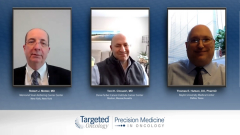
CLEAR Trial: Len + Pembro or Everolimus vs Sunitinib
Thomas Hutson, DO, PharmD, and Toni Choueiri, MD, talk about the phase 3 CLEAR trial at length, including each of the 3 arms of the trial and key data.
Episodes in this series

Thomas E. Hutson, DO, PharmD: This was following the lead of some of the earlier I/O [immuno-oncology]–TKI [tyrosine kinase inhibitor] trials. It was an international effort, combining lenvatinib and an agent was already approved when in combination with everolimus, for differentiated thyroid cancer, and for gynecologic malignancies—like uterine cancer—when combined with pembrolizumab. That combination of lenvatinib-pembrolizumab vs lenvatinib-everolimus has already been approved for refractory RCC [renal cell carcinoma] against sunitinib.
It was a 3-arm trial, but the statistics were designed to compare not lenvatinib-pembrolizumab vs lenvatinib but lenvatinib-pembrolizumab and lenvatinib vs sunitinib individually. There were roughly 350 patients per arm. We’re going to focus on just the lenvatinib-pembrolizumab, the I/O–TKI part of that compared with sunitinib, which was the gold standard. At the first analysis that had been presented, we saw that with 27 months’ follow-up the median overall survival between lenvatinib-pembrolizumab and sunitinib had not been reached but had a hazard ratio of 0.66. We did a landmark overall survival at 12 months and 24 months. They were 90% and 79%, respectively. Median progression-free survival was 23.9 months with the combination lenvatinib-pembrolizumab vs 9.2 months. The hazard ratio there was 0.39. Look at the overall response rate: 71% with lenvatinib-pembrolizumab vs 36% with sunitinib. I like to think about clinical benefit rate, which adds that stable disease factor or the generalizable ability of the drug so that if you take the drug and give it to someone, it’s going to at least produce stable disease. That was sitting above 90% and was very similar to what Toni just mentioned with cabozantinib-nivolumab, a 90% clinical benefit rate.
We can’t really do fair cross-trial comparisons, yet we always do that. It’s in clear cell carcinoma; there are no crossovers. We have a little difference in outcome, and the numbers I just said with lenvatinib-pembrolizumab make it—at least by number—1 of the most active if not the most active I/O–TKI. But we must understand that there’s a follow-up difference among the trials. The trials have different percentages of the prognostic groups in them. The lenvatinib-pembrolizumab trial was heavily weighted on the favorable-risk group at the expense of not having as many of the poor-risk patients in it. The pembrolizumab was traditional dosing, but the lenvatinib was at 20 mg orally daily, which was higher than what traditionally has been used with lenvatinib-everolimus, which is 18 mg.
There are some nuances there that make it unclear: Is this really that much better than the other agents, or can that be explained by other factors? Nonetheless, we would all agree that based on the data presented with lenvatinib-pembrolizumab, the efficacy numbers put it at the higher end of what we see with I/O–TKIs.
The question from there comes into toxicity. We have not reported the health-related quality-of-life outcomes that were reported with CheckMate 9ER. We see that there are adverse effects with the combination of it in that patients do require dose interruption and dose reduction. You had mentioned correctly that it’s generally the TKI that drives that. It’s hard to differentiate among the regimens on tolerability, but when you have similarly active agents, tolerability is going to come into play as the ease of administering the agents will come into play. At the end of the day, the CLEAR study showed us what we were hoping to see, which was that the combination was doable and could be administered. Adverse effects, although they’re present, could be managed. We see efficacy levels of the combination that put it at a very high level as 1 of the most active regimens.
Robert J. Motzer, MD: One of the most interesting aspects of this trial was that it was a 3-arm trial and did have the third arm as lenvatinib-everolimus. The other trials have compared I/O combinations with sunitinib, but they have used a later-generation tyrosine kinase inhibitor that may be better than sunitinib. One of the interesting aspects of this was the lenvatinib-everolimus. What I found interesting was that both lenvatinib-pembrolizumab and lenvatinib-everolimus met their primary objectives by showing longer progression-free survival [PFS]. They also showed higher response rates, but the margin of benefit was longer or better with lenvatinib-pembrolizumab compared to the lenvatinib-everolimus. We saw a survival benefit with lenvatinib-pembrolizumab but not with lenvatinib-everolimus. I interpret that there is an important role for I/O therapy in first-line therapy, that the I/O therapy helps drive the efficacy and result in a longer survival. I found the lenvatinib-pembrolizumab efficacy data particularly impressive with regard to the metrics you mentioned and also a high complete response [CR] rate of 16%. The objective response rate was over 70%. It looks to me like a very effective regimen.
Toni K. Choueiri, MD: I am quite happy that there’s another VEGF–I/O combination to make it here. The compelling thing about lenvatinib-pembrolizumab, as Tom eloquently said, is that we shouldn’t compare across trial. Baseline characteristics are a bit different, with lenvatinib-pembrolizumab having a bit more favorable patients. But I don’t know if that really explains the longest PFS today, which was close to 2 years. And the CR—not just the overall response rate of over 70%, but the CR rate of 16%. These were really quite compelling and intriguing. I look forward very much to the next update from CLEAR to see what are the PFS and CR rates and if they’re going to go up. These are the strongest data with lenvatinib-pembrolizumab, knowing that if you compare it—and you shouldn’t—with cabozantinib-nivolumab, there are more patients with favorable risk and more patients with kidney removal, which we know could influence the PFS and the CRs rate.
This transcript was edited for clarity.








































